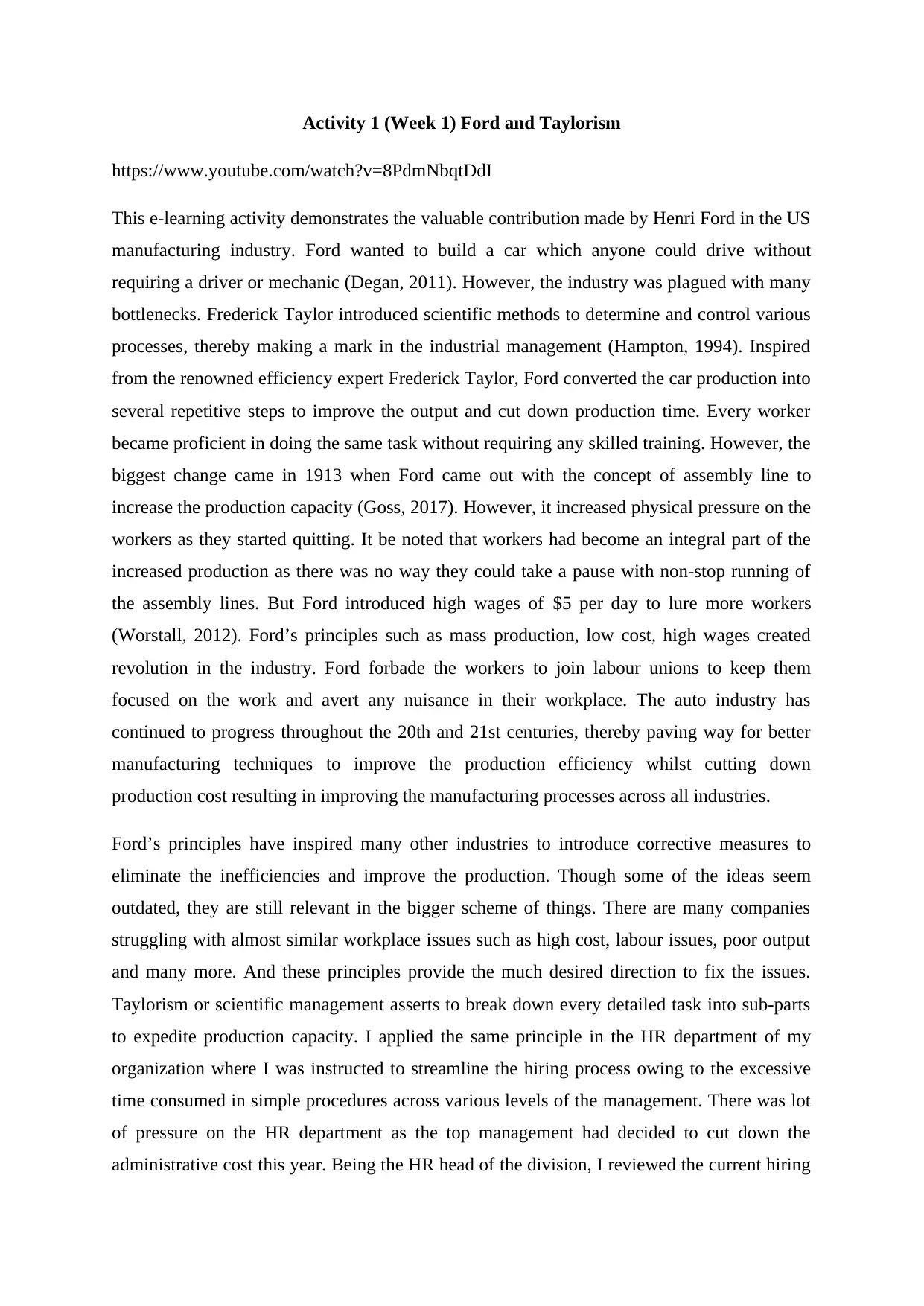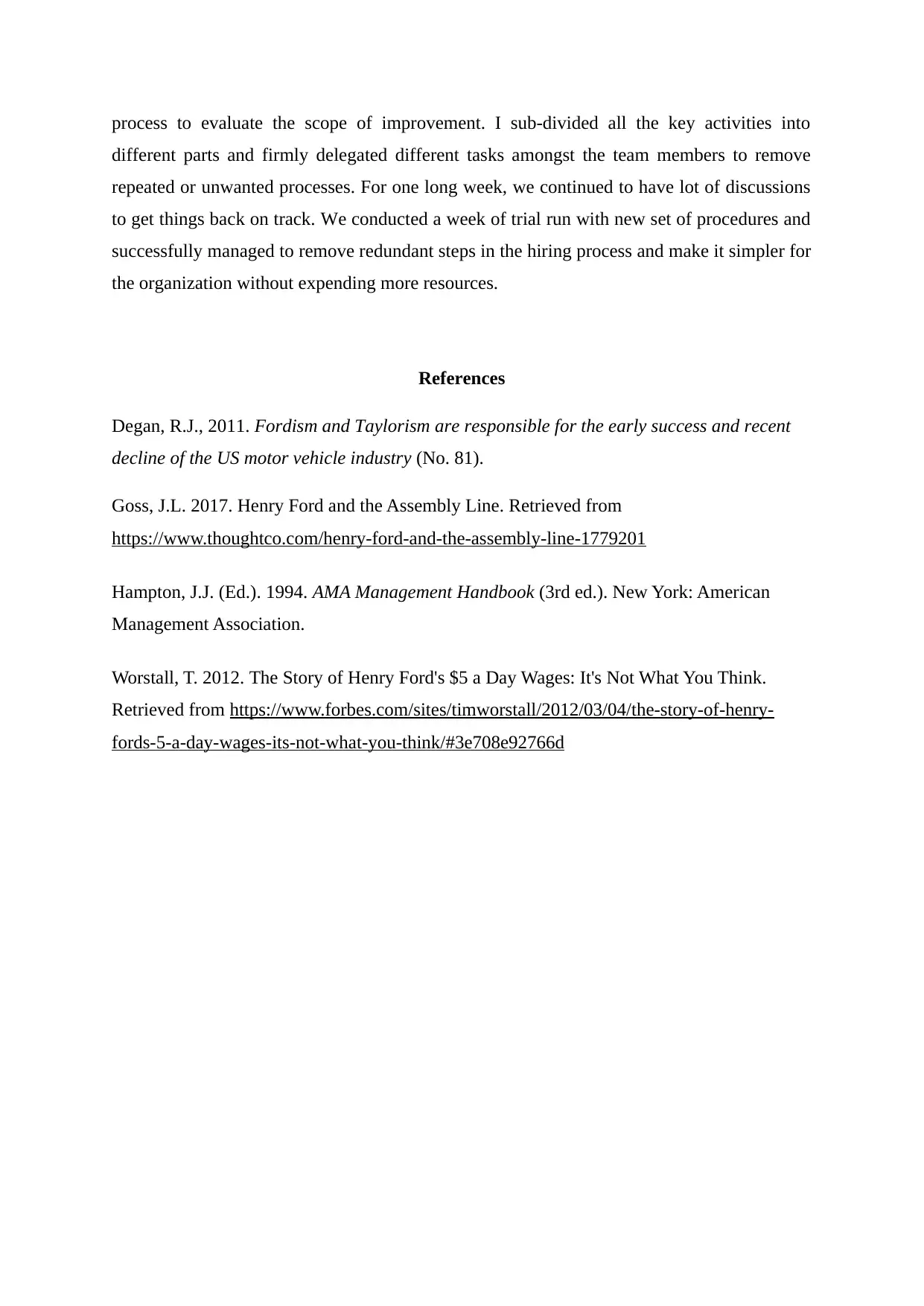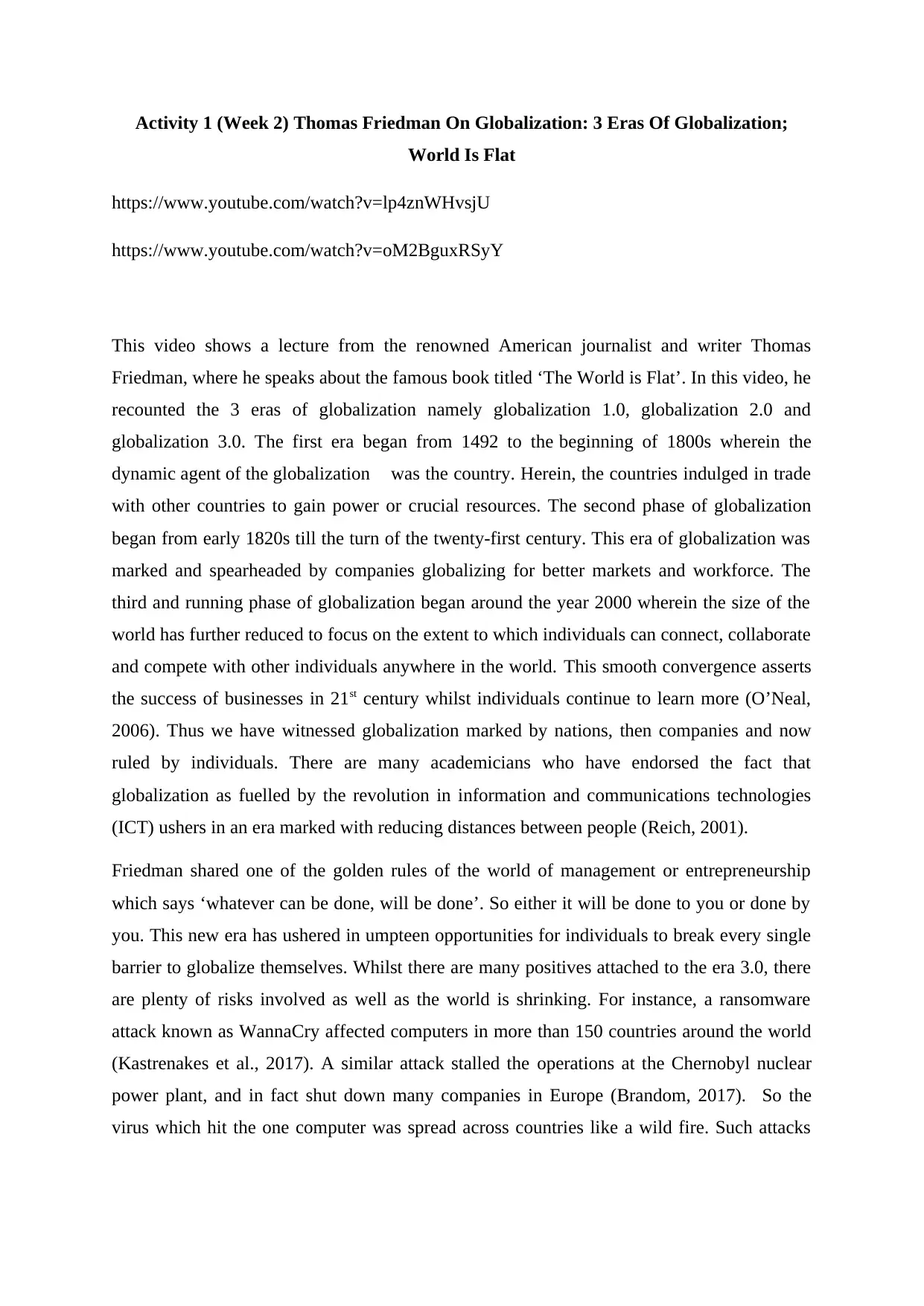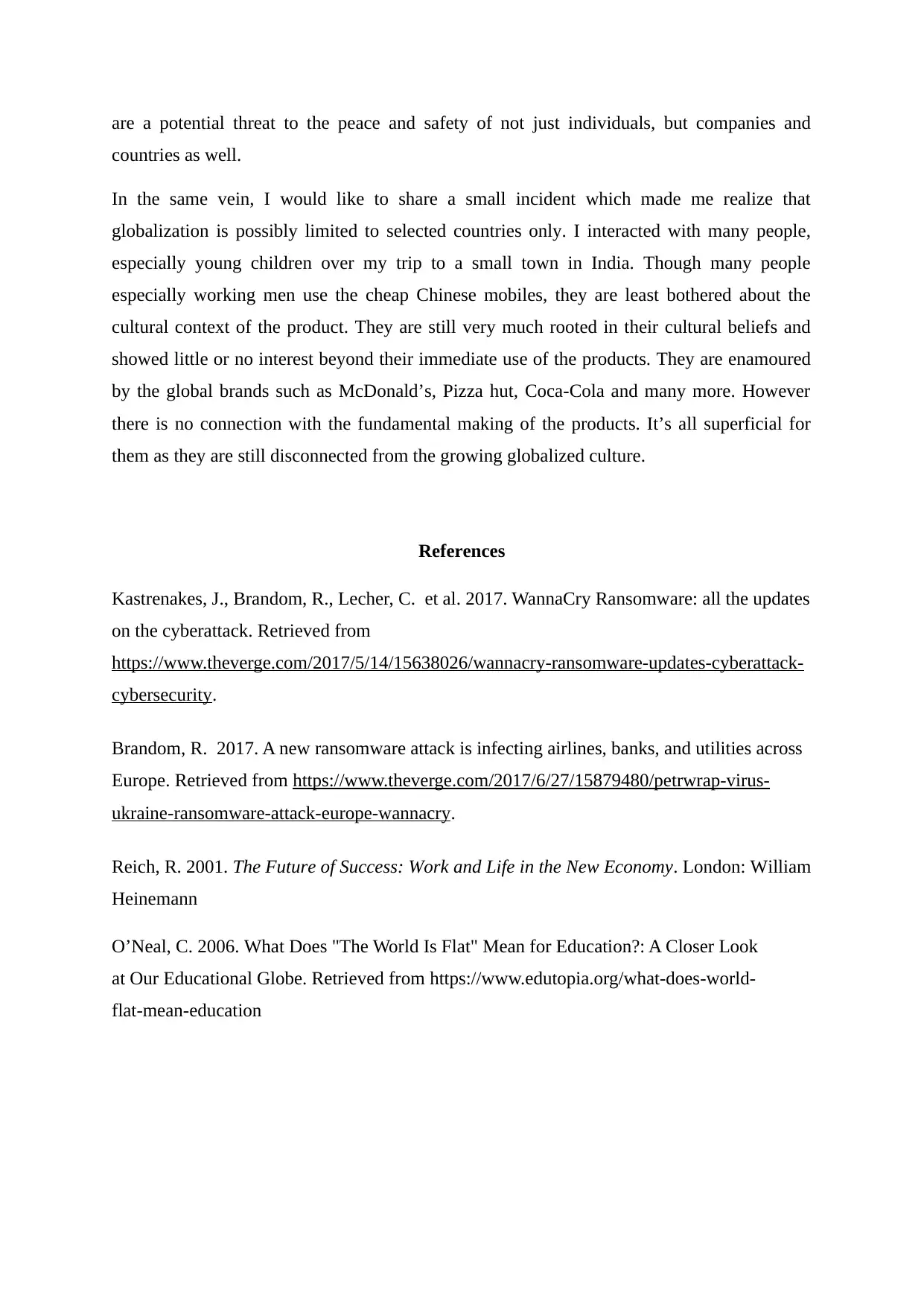Ford's Taylorism and Friedman's Globalization: Business Insights
VerifiedAdded on 2020/03/02
|4
|1390
|59
Homework Assignment
AI Summary
This assignment delves into the contributions of Henry Ford and Thomas Friedman to the fields of business and globalization. It begins by examining Ford's implementation of Taylorism and the assembly line, highlighting their impact on manufacturing efficiency and worker wages. The assignment then shifts to Thomas Friedman's analysis of globalization, outlining its three eras and the increasing interconnectedness of individuals and businesses. The student applies these principles to a real-world scenario, discussing the streamlining of an HR department's hiring process based on Tayloristic principles and reflecting on the limited scope of globalization. The analysis includes key concepts such as mass production, scientific management, and the evolving dynamics of global markets, with references to relevant academic sources and media reports.

Activity 1 (Week 1) Ford and Taylorism
https://www.youtube.com/watch?v=8PdmNbqtDdI
This e-learning activity demonstrates the valuable contribution made by Henri Ford in the US
manufacturing industry. Ford wanted to build a car which anyone could drive without
requiring a driver or mechanic (Degan, 2011). However, the industry was plagued with many
bottlenecks. Frederick Taylor introduced scientific methods to determine and control various
processes, thereby making a mark in the industrial management (Hampton, 1994). Inspired
from the renowned efficiency expert Frederick Taylor, Ford converted the car production into
several repetitive steps to improve the output and cut down production time. Every worker
became proficient in doing the same task without requiring any skilled training. However, the
biggest change came in 1913 when Ford came out with the concept of assembly line to
increase the production capacity (Goss, 2017). However, it increased physical pressure on the
workers as they started quitting. It be noted that workers had become an integral part of the
increased production as there was no way they could take a pause with non-stop running of
the assembly lines. But Ford introduced high wages of $5 per day to lure more workers
(Worstall, 2012). Ford’s principles such as mass production, low cost, high wages created
revolution in the industry. Ford forbade the workers to join labour unions to keep them
focused on the work and avert any nuisance in their workplace. The auto industry has
continued to progress throughout the 20th and 21st centuries, thereby paving way for better
manufacturing techniques to improve the production efficiency whilst cutting down
production cost resulting in improving the manufacturing processes across all industries.
Ford’s principles have inspired many other industries to introduce corrective measures to
eliminate the inefficiencies and improve the production. Though some of the ideas seem
outdated, they are still relevant in the bigger scheme of things. There are many companies
struggling with almost similar workplace issues such as high cost, labour issues, poor output
and many more. And these principles provide the much desired direction to fix the issues.
Taylorism or scientific management asserts to break down every detailed task into sub-parts
to expedite production capacity. I applied the same principle in the HR department of my
organization where I was instructed to streamline the hiring process owing to the excessive
time consumed in simple procedures across various levels of the management. There was lot
of pressure on the HR department as the top management had decided to cut down the
administrative cost this year. Being the HR head of the division, I reviewed the current hiring
https://www.youtube.com/watch?v=8PdmNbqtDdI
This e-learning activity demonstrates the valuable contribution made by Henri Ford in the US
manufacturing industry. Ford wanted to build a car which anyone could drive without
requiring a driver or mechanic (Degan, 2011). However, the industry was plagued with many
bottlenecks. Frederick Taylor introduced scientific methods to determine and control various
processes, thereby making a mark in the industrial management (Hampton, 1994). Inspired
from the renowned efficiency expert Frederick Taylor, Ford converted the car production into
several repetitive steps to improve the output and cut down production time. Every worker
became proficient in doing the same task without requiring any skilled training. However, the
biggest change came in 1913 when Ford came out with the concept of assembly line to
increase the production capacity (Goss, 2017). However, it increased physical pressure on the
workers as they started quitting. It be noted that workers had become an integral part of the
increased production as there was no way they could take a pause with non-stop running of
the assembly lines. But Ford introduced high wages of $5 per day to lure more workers
(Worstall, 2012). Ford’s principles such as mass production, low cost, high wages created
revolution in the industry. Ford forbade the workers to join labour unions to keep them
focused on the work and avert any nuisance in their workplace. The auto industry has
continued to progress throughout the 20th and 21st centuries, thereby paving way for better
manufacturing techniques to improve the production efficiency whilst cutting down
production cost resulting in improving the manufacturing processes across all industries.
Ford’s principles have inspired many other industries to introduce corrective measures to
eliminate the inefficiencies and improve the production. Though some of the ideas seem
outdated, they are still relevant in the bigger scheme of things. There are many companies
struggling with almost similar workplace issues such as high cost, labour issues, poor output
and many more. And these principles provide the much desired direction to fix the issues.
Taylorism or scientific management asserts to break down every detailed task into sub-parts
to expedite production capacity. I applied the same principle in the HR department of my
organization where I was instructed to streamline the hiring process owing to the excessive
time consumed in simple procedures across various levels of the management. There was lot
of pressure on the HR department as the top management had decided to cut down the
administrative cost this year. Being the HR head of the division, I reviewed the current hiring
Paraphrase This Document
Need a fresh take? Get an instant paraphrase of this document with our AI Paraphraser

process to evaluate the scope of improvement. I sub-divided all the key activities into
different parts and firmly delegated different tasks amongst the team members to remove
repeated or unwanted processes. For one long week, we continued to have lot of discussions
to get things back on track. We conducted a week of trial run with new set of procedures and
successfully managed to remove redundant steps in the hiring process and make it simpler for
the organization without expending more resources.
References
Degan, R.J., 2011. Fordism and Taylorism are responsible for the early success and recent
decline of the US motor vehicle industry (No. 81).
Goss, J.L. 2017. Henry Ford and the Assembly Line. Retrieved from
https://www.thoughtco.com/henry-ford-and-the-assembly-line-1779201
Hampton, J.J. (Ed.). 1994. AMA Management Handbook (3rd ed.). New York: American
Management Association.
Worstall, T. 2012. The Story of Henry Ford's $5 a Day Wages: It's Not What You Think.
Retrieved from https://www.forbes.com/sites/timworstall/2012/03/04/the-story-of-henry-
fords-5-a-day-wages-its-not-what-you-think/#3e708e92766d
different parts and firmly delegated different tasks amongst the team members to remove
repeated or unwanted processes. For one long week, we continued to have lot of discussions
to get things back on track. We conducted a week of trial run with new set of procedures and
successfully managed to remove redundant steps in the hiring process and make it simpler for
the organization without expending more resources.
References
Degan, R.J., 2011. Fordism and Taylorism are responsible for the early success and recent
decline of the US motor vehicle industry (No. 81).
Goss, J.L. 2017. Henry Ford and the Assembly Line. Retrieved from
https://www.thoughtco.com/henry-ford-and-the-assembly-line-1779201
Hampton, J.J. (Ed.). 1994. AMA Management Handbook (3rd ed.). New York: American
Management Association.
Worstall, T. 2012. The Story of Henry Ford's $5 a Day Wages: It's Not What You Think.
Retrieved from https://www.forbes.com/sites/timworstall/2012/03/04/the-story-of-henry-
fords-5-a-day-wages-its-not-what-you-think/#3e708e92766d

Activity 1 (Week 2) Thomas Friedman On Globalization: 3 Eras Of Globalization;
World Is Flat
https://www.youtube.com/watch?v=lp4znWHvsjU
https://www.youtube.com/watch?v=oM2BguxRSyY
This video shows a lecture from the renowned American journalist and writer Thomas
Friedman, where he speaks about the famous book titled ‘The World is Flat’. In this video, he
recounted the 3 eras of globalization namely globalization 1.0, globalization 2.0 and
globalization 3.0. The first era began from 1492 to the beginning of 1800s wherein the
dynamic agent of the globalization was the country. Herein, the countries indulged in trade
with other countries to gain power or crucial resources. The second phase of globalization
began from early 1820s till the turn of the twenty-first century. This era of globalization was
marked and spearheaded by companies globalizing for better markets and workforce. The
third and running phase of globalization began around the year 2000 wherein the size of the
world has further reduced to focus on the extent to which individuals can connect, collaborate
and compete with other individuals anywhere in the world. This smooth convergence asserts
the success of businesses in 21st century whilst individuals continue to learn more (O’Neal,
2006). Thus we have witnessed globalization marked by nations, then companies and now
ruled by individuals. There are many academicians who have endorsed the fact that
globalization as fuelled by the revolution in information and communications technologies
(ICT) ushers in an era marked with reducing distances between people (Reich, 2001).
Friedman shared one of the golden rules of the world of management or entrepreneurship
which says ‘whatever can be done, will be done’. So either it will be done to you or done by
you. This new era has ushered in umpteen opportunities for individuals to break every single
barrier to globalize themselves. Whilst there are many positives attached to the era 3.0, there
are plenty of risks involved as well as the world is shrinking. For instance, a ransomware
attack known as WannaCry affected computers in more than 150 countries around the world
(Kastrenakes et al., 2017). A similar attack stalled the operations at the Chernobyl nuclear
power plant, and in fact shut down many companies in Europe (Brandom, 2017). So the
virus which hit the one computer was spread across countries like a wild fire. Such attacks
World Is Flat
https://www.youtube.com/watch?v=lp4znWHvsjU
https://www.youtube.com/watch?v=oM2BguxRSyY
This video shows a lecture from the renowned American journalist and writer Thomas
Friedman, where he speaks about the famous book titled ‘The World is Flat’. In this video, he
recounted the 3 eras of globalization namely globalization 1.0, globalization 2.0 and
globalization 3.0. The first era began from 1492 to the beginning of 1800s wherein the
dynamic agent of the globalization was the country. Herein, the countries indulged in trade
with other countries to gain power or crucial resources. The second phase of globalization
began from early 1820s till the turn of the twenty-first century. This era of globalization was
marked and spearheaded by companies globalizing for better markets and workforce. The
third and running phase of globalization began around the year 2000 wherein the size of the
world has further reduced to focus on the extent to which individuals can connect, collaborate
and compete with other individuals anywhere in the world. This smooth convergence asserts
the success of businesses in 21st century whilst individuals continue to learn more (O’Neal,
2006). Thus we have witnessed globalization marked by nations, then companies and now
ruled by individuals. There are many academicians who have endorsed the fact that
globalization as fuelled by the revolution in information and communications technologies
(ICT) ushers in an era marked with reducing distances between people (Reich, 2001).
Friedman shared one of the golden rules of the world of management or entrepreneurship
which says ‘whatever can be done, will be done’. So either it will be done to you or done by
you. This new era has ushered in umpteen opportunities for individuals to break every single
barrier to globalize themselves. Whilst there are many positives attached to the era 3.0, there
are plenty of risks involved as well as the world is shrinking. For instance, a ransomware
attack known as WannaCry affected computers in more than 150 countries around the world
(Kastrenakes et al., 2017). A similar attack stalled the operations at the Chernobyl nuclear
power plant, and in fact shut down many companies in Europe (Brandom, 2017). So the
virus which hit the one computer was spread across countries like a wild fire. Such attacks
⊘ This is a preview!⊘
Do you want full access?
Subscribe today to unlock all pages.

Trusted by 1+ million students worldwide

are a potential threat to the peace and safety of not just individuals, but companies and
countries as well.
In the same vein, I would like to share a small incident which made me realize that
globalization is possibly limited to selected countries only. I interacted with many people,
especially young children over my trip to a small town in India. Though many people
especially working men use the cheap Chinese mobiles, they are least bothered about the
cultural context of the product. They are still very much rooted in their cultural beliefs and
showed little or no interest beyond their immediate use of the products. They are enamoured
by the global brands such as McDonald’s, Pizza hut, Coca-Cola and many more. However
there is no connection with the fundamental making of the products. It’s all superficial for
them as they are still disconnected from the growing globalized culture.
References
Kastrenakes, J., Brandom, R., Lecher, C. et al. 2017. WannaCry Ransomware: all the updates
on the cyberattack. Retrieved from
https://www.theverge.com/2017/5/14/15638026/wannacry-ransomware-updates-cyberattack-
cybersecurity.
Brandom, R. 2017. A new ransomware attack is infecting airlines, banks, and utilities across
Europe. Retrieved from https://www.theverge.com/2017/6/27/15879480/petrwrap-virus-
ukraine-ransomware-attack-europe-wannacry.
Reich, R. 2001. The Future of Success: Work and Life in the New Economy. London: William
Heinemann
O’Neal, C. 2006. What Does "The World Is Flat" Mean for Education?: A Closer Look
at Our Educational Globe. Retrieved from https://www.edutopia.org/what-does-world-
flat-mean-education
countries as well.
In the same vein, I would like to share a small incident which made me realize that
globalization is possibly limited to selected countries only. I interacted with many people,
especially young children over my trip to a small town in India. Though many people
especially working men use the cheap Chinese mobiles, they are least bothered about the
cultural context of the product. They are still very much rooted in their cultural beliefs and
showed little or no interest beyond their immediate use of the products. They are enamoured
by the global brands such as McDonald’s, Pizza hut, Coca-Cola and many more. However
there is no connection with the fundamental making of the products. It’s all superficial for
them as they are still disconnected from the growing globalized culture.
References
Kastrenakes, J., Brandom, R., Lecher, C. et al. 2017. WannaCry Ransomware: all the updates
on the cyberattack. Retrieved from
https://www.theverge.com/2017/5/14/15638026/wannacry-ransomware-updates-cyberattack-
cybersecurity.
Brandom, R. 2017. A new ransomware attack is infecting airlines, banks, and utilities across
Europe. Retrieved from https://www.theverge.com/2017/6/27/15879480/petrwrap-virus-
ukraine-ransomware-attack-europe-wannacry.
Reich, R. 2001. The Future of Success: Work and Life in the New Economy. London: William
Heinemann
O’Neal, C. 2006. What Does "The World Is Flat" Mean for Education?: A Closer Look
at Our Educational Globe. Retrieved from https://www.edutopia.org/what-does-world-
flat-mean-education
1 out of 4
Related Documents
Your All-in-One AI-Powered Toolkit for Academic Success.
+13062052269
info@desklib.com
Available 24*7 on WhatsApp / Email
![[object Object]](/_next/static/media/star-bottom.7253800d.svg)
Unlock your academic potential
Copyright © 2020–2025 A2Z Services. All Rights Reserved. Developed and managed by ZUCOL.




